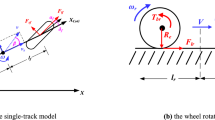Abstract
The 5-DOF vehicle model employs the classical tire-slip-angle model to elicit the stability characteristics in vehicle handling during chaotic motion. However, the energy is not conserved, and the simulation results do not match actual behavior in that the vehicle should stop having lost balance. We have analyzed the limitations of the classical tire-slip-angle equation, and developed another model, which can be applied to all conditions. To ensure the correct use of the Pacejka’s magic formula for vehicle dynamics, we discuss the differences in tire axis systems between the ISO and adapted SAE (Pacejka), and propose a transformation method relating the two different tire axis systems. Finally, simulations are described that are performed in accordance with the established 5-DOF vehicle system dynamics model. The simulation results show that all states returned to the stable region after the vehicle had lost balance. The process involved energy dissipation, and approaches the response actually experienced. The limitations of the classical tire-slip-angle model are fully displayed and the effectiveness of the proposed slip angle model is demonstrated in unsteady vehicle states.










Similar content being viewed by others
Abbreviations
- DOF:
-
Degree of freedom
- ISO:
-
International Standardization Organization
- SAE:
-
Society of Automotive Engineers
- MF:
-
Magic formula
- CG:
-
Center of gravity of vehicle
- \(v_\mathrm{x} ,v_\mathrm{y} \) :
-
Longitudinal and lateral velocity at the CG, respectively.
- \(v_\mathrm{x1} ,v_\mathrm{y1} ,v_\mathrm{x2} ,v_\mathrm{y2}\) :
-
Longitudinal and lateral velocity of front and rear tires under the vehicle coordinate system respectively.
- \(v_\mathrm{xf} ,v_\mathrm{yf} ,v_\mathrm{xr} ,v_\mathrm{yr}\) :
-
Longitudinal and lateral velocity of front and rear tires under the wheel coordinate system respectively.
- \(\delta _\mathrm{f}\) :
-
Front wheel steering angle
- a, b :
-
Distance from CG to front and rear axles, respectively.
- \(\alpha _\mathrm{f} ,\alpha _\mathrm{r}\) :
-
Slip angle at front and rear tires respectively.
- \(\omega \) :
-
Yaw rate of vehicle
- k :
-
Tire slip ratio
- \(\omega _\mathrm{w}\) :
-
Angular speed of wheel
- \(R_\mathrm{e} \) :
-
Rolling radius of wheel
- \(v_\mathrm{wx}\) :
-
Longitudinal velocity of wheel center in wheel plane
- m :
-
Mass of the vehicle
- \(I_\mathrm{z} \) :
-
Moment of inertia of vehicle
- \(F_\mathrm{yf} ,F_\mathrm{yr}\) :
-
Lateral force at front and rear tires, respectively.
- \(F_\mathrm{xf} ,F_\mathrm{xr}\) :
-
Longitudinal tire force at front and rear tires respectively.
- \(\omega _\mathrm{f} ,\omega _\mathrm{r}\) :
-
Angular velocity of front and rear tires respectively.
- \(T_\mathrm{bf} ,T_\mathrm{br}\) :
-
Braking torque on front and rear respectively.
- \(T_\mathrm{d}\) :
-
Torque to driving wheels
- J :
-
Wheel moment of inertia
- \(C_\mathrm{x}\) :
-
Drag coefficient
- \(A_\mathrm{Lx}\) :
-
Frontal area of the vehicle
- \(\rho \) :
-
Mass density of air
References
True, H.: On the theory of nonlinear dynamics and its applications in vehicle systems dynamics. Veh. Syst. Dyn. 31(5–6), 393–421 (2010)
Shen, S., Veldpaus, F.E.: Analysis and control of a flywheel hybrid vehicular powertrain. IEEE Trans. Control Syst. Technol. 12(5), 645–60 (2004)
Shen, S., Wang, J., et al.: Nonlinear dynamics and stability analysis of vehicle plane motions. Veh. Syst. Dyn. 45(1), 15–35 (2007)
Vieira, R.S., Roqueiro, N.: Four-wheel vehicle kinematic and geometric constraints for definition of tire slip angle. Int. J. Automot. Technol. 13(4), 553–62 (2012)
Hajiahmad, A., Goli, H., et al.: Side slip angle prediction model of an off-road tire on different terrains. J. Terrramech. 56(1), 25–35 (2014)
Garcia-Pozuelo, D., Yunta, J., et al.: A strain-based method to estimate slip angle and tire working conditions for intelligent tires using fuzzy logic. Sensors 17(4), 874 (2017)
Song, S.H., Ahn, M., et al.: Performance Analysis of EKF and UKF for Estimating Tire Longitudinal and Side Angle Slip. In: MATEC Web of Conferences (2016)
Arat, M.A., Singh, K., Taheri, S.: An adaptive vehicle stability control algorithm based on tire slip-angle estimation. SAE Technical Papers (2012)
Hsu, Y.H.J., Laws, S.M., Gerdes, J.C.: Estimation of tire slip angle and friction limits using steering torque. IEEE Trans. Control Syst. Technol. 18(4), 896–907 (2010)
Rajamani, R.: Vehicle Dynamics and Control. Springer, Berlin (2005)
Mitschke, M., Wallentowitz, H.: Dynamik der Kraftfahrzeuge. VDI-Buch, pp. 438–465 (2004)
Abdulrahim, M.: On the Dynamics of Automobile Drifting. Society of Automotive Engineers World Congress (2006)
Hindiyeh, R.: Design of a dynamic surface controller for vehicle sideslip angle during autonomous drifting. Adv. Automot. Control 43, 560–565 (2010)
Voser, C., Hindiyeh, R., et al.: Analysis and control of high sideslip manoeuvres. Veh. Syst. Dyn. 48(S1), 317–336 (2010)
Pacejka, H.B.: Tire and Vehicle Dynamics, 2nd edn. Elsevier, Oxford (2006)
Pacejka, H.B., Bakker, E.: The magic formula tyre model. Veh. Syst Dyn. 21(S1), 18 (1992)
Guo, K.H.: Vehicle Handling Dynamics. Jilin Science and Technology Press, Changchun (1991)
Fiala, E.: Seitenkrafte am rollenden luftreifenU. ZVDI 29(11), 81–92 (1954)
Gim, G., Nikravesh, P.E.: A three dimensional tire model for steady-state simulations of vehicles. In: International Pacific Conference On Automotive Engineering (1993)
Wang, X.B.: Coupling bifurcation of vehicle driving torque and steering angle and solution of driving stability region. Doctoral Theses, Jilin University, Changchun (2014)
Yu, Z.S.: The Theory of Aotumible. China Machine Press, Beijing (2009)
ISO 8855:1991-12: Road vehicles—vehicle dynamics and road-holding ability (2011)
SAE J760e: Vehicle Dynamics Terminology, Warrendale, PA (1976)
Yu, F., Lin, Y.: Vehicle System Dynamics. China Mechine Press, Beijing (2005)
Liu, L.: Nonlinear Analysis and Control Strategy Evaluation on the Stability of Vehicle 3-DOF Planar Motion. Doctoral Theses, Jilin University, Changchun (2010)
Liu, W., Xiong, L., et al.: Vehicle stability criterion research based on phase plane method. \(\text{WCX}^{\rm TM}\) 17: SAE World Congress Experience (2017)
Acknowledgements
This research is supported by the project of National Science Foundation China (Grant No. 51475199).
Author information
Authors and Affiliations
Corresponding author
Rights and permissions
About this article
Cite this article
Mu, Y., Li, L. & Shi, S. Modified Tire-Slip-Angle Model for Chaotic Vehicle Steering Motion. Automot. Innov. 1, 177–186 (2018). https://doi.org/10.1007/s42154-018-0019-7
Received:
Accepted:
Published:
Issue Date:
DOI: https://doi.org/10.1007/s42154-018-0019-7




